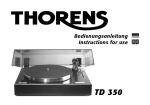Download Thorens TD 295 MK IV
Transcript
Bedienungsanleitung Instructions for Use TD 295 MKIV Deutsches Inhaltsverzeichnis: Aufbau 4 Anschließen 5 Tonarm 6 Einstellungen 7 Technische Daten 10 Garantie 10 English Table of Contents: Setup 12 Connections 13 Tonearm 14 Adjustments 15 Technical Specifications 18 Warranty 2 18 Bitte prüfen Sie den Inhalt Ihrer Verpackung! Packungsinhalt: 1 x Chassis 1 x Bedienungsanleitung 1 x Antriebsriemen 1 x Steckernetzteil 1 x Adapter für Single-Schallplatten 1 x Antiskatinggewicht 1 x Gegengewicht für den Tonarm 1 x Staubschutzhaube 1 x Cinchkabel 1 x Plattenteller mit Filzmatte Konformitätserklärung: Wir bestätigen, dass das Gerät, zu dem diese Bedienungsanleitung gehört, den zum Zeitpunkt der Drucklegung gültigen EG-Richtlinien zur Erlangung des CE-Zeichens entspricht. Die notwendigen Prüfungen wurden mit positivem Ergebnis vorgenommen. Please check if each of the following items has been supplied: 1 x Record player chassis 1 x Instructions for Use 1 x Drive belt 1 x Mains transformer unit 1 x Adaptor for single records 1 x Anti-skating weight 1 x Tonearm counterweight 1 x Dust cover 1 x RCA interconnect 1 x Platter with felt mat Declaration of Conformity This is to certify that the device, to which this instruction manual belongs and by the time this manual was printed, has been manufactured in accordance to valid EC regulations in order to obtain the CE-label. All required examinations and tests have successfully been carried out. Sehr geehrter Thorens-Kunde, in die Kulturgeschichte des 20. Jahrhunderts geht die Erfindung der Schallplatte als eine ihrer wichtigsten Erfindungen ein. Ihr THORENS-Plattenspieler TD 295 MK IV läßt Sie in optimaler Weise daran teilhaben. „In optimaler Weise“ bedeutet hier die perfekte Ausnutzung der Tonqualität der Schallplatte bei gleichzeitig größtmöglicher Schonung ihrer Schallrillen. THORENS-Plattenspieler besitzen ein besonders schweres Chassis aus einem akustisch stark dämpfenden Holzwerkstoff. Dadurch werden störende, die Klangeigenschaften beeinträchtigende, Resonanzen unterdrückt. Sein äußerst ruhig laufender Synchronmotor wird aus einem präzise arbeitenden elektronischen Generator gespeist. Er hält störende Einflüsse, die vom Stromnetz kommen könnten, vom Gerät fern. Der TD 295 MK IV ist ein Präzisionsgerät, das bei sachgemäßer Behandlung über viele Jahre seine hervorragenden Eigenschaften behält. Bitte lesen Sie diese Bedienungsanleitung, bevor Sie Ihr Gerät auspacken und in Betrieb nehmen. Sie vermeiden dadurch Schäden am Gerät und an Ihren Schallplatten. Ihr Thorens-Team 3 Verwendung Ihr Plattenspieler wurde ausschließlich zur Verwendung in geschlossenen Räumen konstruiert. Bitte verwenden Sie ihn deshalb nur in Wohnräumen. Achten Sie darauf, dass er keiner Feuchtigkeit ausgesetzt wird. Das externe Netzteil wird mit 230 V Netzspannung betrieben. Bitte ziehen Sie vor dem Öffnen unbedingt den Netzstecker. 1. Aufbau des Gerätes Den Gummiantriebsriemen um den inneren Plattenteller und die Riemenscheibe legen. Dann den äußeren Plattenteller auf den Innenteller aufsetzen und die Filzmatte auflegen (Abbildung 1). Abbildung1 Vermeiden Sie Öl- oder Fettspuren auf Antriebsriemen, Motor-Riemenscheibe und der Lauffläche des inneren Plattentellers. Falls notwendig, sind diese Teile mit einem in reinem Alkohol getränkten, nicht fasernden Lappen zu reinigen. Nun wird die Staubschutzhaube in die Scharniere am Chassis eingeschoben (Abbildung 2). 4 Abbildung 2 2. Anschließen und Aufstellen des Plattenspielers Durch die Auswahl eines entsprechenden THORENS-Netztransformators kann der Plattenspieler an allen vorkommenden Netzwechselspannungen betrieben werden. Der Niederspannungsstecker am Kabel des Steckernetztransformators wird in die entsprechende Buchse an der Geräterückseite gesteckt (Abbildung 3). Verbinden Sie das mitgelieferte Cinchkabel mit den Cinchbuchsen am Plattenspieler und den Phono-Anschlußbuchsen an Ihrem Verstärker (Achten Sie hierbei auf korrekte Verpolung). Die getrennt geführte Litze stellt die Erd- oder Masseverbindung her. Verbinden Sie diese mit der Masseschraube am Plattenspieler und am Verstärker. Besitzt Ihr Verstärker keine Masseschraube, so können Sie das Kabel am Außenrand einer nicht benutzten Eingangsbuchse anklemmen (Abbildung 4). Rückansicht Für Verstärker mit einer 5-poligen Eingangsbuchse nach DIN benötigen Sie ein Adapterkabel von Ihrem Fachhändler. Die vielen Möglichkeiten beim Erdanschluß führen manchmal zu einer fehlerhaften Erdverbindung. Sie äußert sich in Abbildung 3 Abbildung 4 5 einem Brummgeräusch in den Lautsprechern, dessen Lautstärke sich mit dem Lautstärkeregler beeinflussen lässt. Bei seinem Auftreten sollte zunächst untersucht werden, ob die Masseverbindung einen sicheren Kontakt am Verstärker aufweist. Ist dieses Brummgeräusch durch eigene Versuche mit der Erdverbindung nicht zu beseitigen, sollten Sie sich mit Ihrem Fachhändler in Verbindung setzten. Eine weitere Quelle für Brummstörungen stellt die mögliche magnetische Einstrahlung des Netzteiles anderer Geräte (z.B. Verstärker, Receiver, CD-Player, Tuner usw.) auf das Tonabnehmersystem dar. Solche Fehlerursachen kann man leicht selbst ermitteln, indem man die Aufstellung des Plattenspielers gegenüber den anderen Geräten verändert. Obwohl THORENS-Plattenspieler gegenüber Erschütterun- 6 Abbildung 5 gen sehr unempfindlich sind, stellen diese ein generelles Problem bei der Plattenwiedergabe mit hochwertigen Tonabnehmern dar. Man wähle ein stabiles Möbel für seine Aufstellung und vermeide die Nähe von Lautsprechern. Bisweilen reicht dies in älteren Häusern mit Holzbalkendecken nicht aus. Hier hilft meistens die Aufstellung des Plattenspielers auf einer Konsole, die mit geeigneten Konsolenträgern an eine tragende Zimmerwand geschraubt ist. 3. Tonarm und Tonabnehmersystem Wurde der Plattenspieler mit einem bereits montierten Tonabnehmer geliefert, so brauchen die nachfolgenden ersten Absätze dieses Kapitels, die sich mit der Montage befassen, nicht beachtet werden. 3.1. Montage und Justierung des Tonabnehmers 4. Einstellen der Auflagekraft Am Tonarm TP 41 (Abbildung 5) können nahezu alle auf dem Markt befindlichen Tonabnehmer mit dem standardisierten Abstand der Befestigungslöcher von 12,5 mm (1/2 inch) montiert werden. Das Gegengewicht wird von hinten auf das Tonarmrohr geschoben und im Uhrzeigersinn aufgedreht. Der Tonarm wird nun bei abgesenktem Lift zwischen Tonarmstütze und Plattenteller postiert (Abbildung 6). Durch verdrehen des Gegengewichts wird jetzt der Tonarm ausbalanciert. Danach wird der Tonarm wieder in die Tonarmstütze eingerastet. Zur Einstellung der Auflagekraft wird nun das Gegengewicht mit einer Hand am Verdrehen gehindert, während mit der anderen Hand die vorne am Gegengewicht befindliche Skalenscheibe auf Null gedreht wird. D.h., die Ziffer Null muß senkrecht über dem Einstellstrich des Tonarmrohres stehen. Die vier farblich gekennzeichneten Anschlußlitzen werden auf die entsprechenden Anschluß-Stifte (gleiche Farbe) des Tonabnehmersystems geschoben. Ältere Tonabnehmer weisen manchmal diese Kennfarben nicht auf. Es bedeutet: Weiß Blau Rot Grün – – – – linker Kanal, Innenleiter, (Signal) linker Kanal, Außenleiter, (Masse) rechter Kanal, Innenleiter, (Signal) rechter Kanal, Außenleiter, (Masse) 3.2. Technische Daten Audio Technika AT-95E • Auflagekraft: 1,5 – 2,5 g • Empf. Auflagekraft: 2 g Die gewünschte Auflagekraft kann nun durch Verdrehen des Gegengewichtes im Uhrzeigersinn eingestellt werden. Abbildung 6 7 Rille 1 Rille 2 5. Einstellen der Antiskatingkraft Rille 3 Die Reibung zwischen dem Abtastdiamant und der Schallrille erzeugt eine Kraft, die den Tonarm nach innen in Richtung Plattenetikett ziehen will. Man nennt sie Skatingkraft. Sie ist unerwünscht, denn sie bewirkt, dass die Auflagekraft auf der Innenwand der Rille stärker als auf der Außenwand ist. Mit dem Antiskatinggewicht das am Einhängungsstift des Tonarmes über den Drahtbügel eingehängt wird, kann man die Skatingkraft kompensieren. Weil die Stärke der Skatingkraft von der gewählten Auflagekraft abhängt, muss man die Antiskatingkraft entsprechend einstellen. Die Einstellbereiche sind in die Rillen 1, 2 und 3 am Einhängestift aufgeteilt. Rille 1 = entsprechende Auflagekraft Rille 2 = entsprechende Auflagekraft Rille 3 = entsprechende Auflagekraft 8 10 – 15 mN 15 – 20 mN > 20 mN Abbildung 7 6. Bedienung des TD 295 MK IV 7. Tonarmlift Der links vom Plattenteller angeordnete Drehknopf dient zur Wahl der Geschwindigkeiten (33 / 45). Rechts neben dem Drehknopf befindet sich die Start/Stop-Taste (Abbildung 8). Den Tonarm über die Einlaufrille der Schallplatte oder über den Anfang des gewünschten Stückes positionieren. Danach wird durch Umlegen des Lifthebels nach vorne der Tonarm auf die Schallplatte abgesenkt. 6.1. Geschwindigkeitswahl und Start 7.1. Endabschaltung Wählen Sie für Langspielplatten mit dem Wahlschalter 33 Umdrehungen pro Minute aus und für kleine Platten 45 Umdrehungen pro Minute. Zum Starten des Plattenspielers drücken Sie die Start/Stop-Taste. Abbildung 8 Erreicht der Tonarm die Auslaufrille, so tritt eine elektronische Abschaltvorrichtung in Tätigkeit: Das Gerät wird ausgeschaltet. Den Tonarm mittels Handlift von der Platte abheben. Soll der Plattenspieler ausgeschaltet werden, bevor der Tonarm die Auslaufrille erreicht hat, drückt man die Start/StopTaste. Der Tonarm wird mittels Handlift von der Platte abgehoben. Abbildung 9 9 Technische Daten THORENS-Werksgarantie Für weitere Fragen steht Ihnen unser Service gerne zur Verfügung unter: e-mail: [email protected] Technische Änderungen vorbehalten. Wir verpflichten uns, fehlerhafte Teile dieses Gerätes kostenlos zu ersetzen oder das Gerät in unseren, bzw. von uns anerkannten Vertragswerkstätten kostenlos Instandzusetzen, falls es innerhalb der Garantiezeit versagen sollte. Diese beträgt 2 Jahre vom Kaufdatum an gerechnet. TD 295 MKIV Antriebsystem: Riemenantrieb (geschliffener Präzisionsriemen) Antrieb: elektronisch geregelter AC-Synchronmotor Geschwindigkeiten: 33, 45 U/min Geschwindigkeitsumschaltung: elektronisch Plattenteller: 304 mm/2,3 kg, nicht magnetisch Tonarm: Thorens TP 41 mit AT-95E Tonabnehmersystem Antiskating: Gewicht Automatik: halbautomatisch Endabschaltung: optoelektronisch Kabelkapazität: 160 pF Stromversorgung: Steckernetzteil verfügbar für alle wichtigen Stromnetze Abmessungen (BxTxH): 434 x 339 x 131 mm Gewicht: 8,5 kg Farbausführung: Pianolack Schwarz Pianolack Mahagoni Pianolack Anis 10 Tritt innerhalb der Garantiezeit ein Mangel an Ihrem Gerät auf, so wenden Sie sich bitte an Ihren Händler. Falls das Gerät zurückzusenden ist, verpacken Sie es gemäß den Angaben in der Bedienungsanleitung in der Originalverpackung. Porto und Versicherung sind vom Absender zu bezahlen. Fehler, die durch Nichtbeachtung der Bedienungsanleitung, ferner durch äußere mechanische Einwirkungen entstehen, sowie Transportschäden sind durch diese Garantie nicht gedeckt. Die Garantie erlischt, wenn das Gerät außerhalb des offiziellen THORENS-Service geändert, demontiert oder repariert wurde. NB: Bitte beachten Sie evtl. ergänzende Garantiebestimmungen unserer jeweiligen Landesvertreter. Dear THORENS customer: The invention of the phonograph record is one of the most significant events in the cultural history of the 20th Century. Your THORENS record player TD 295 MK IV provides you with the opportunity to experience the culmination of this development. This means the realisation of optimum audio quality from your vinyl records with the highest possible protection of the modulated grooves. THORENS record players feature a particularly heavy plinth made of an acoustically "dead" woodcompound. Owing to this material any distortions that may have a deteriorating influence on the sonic properties are effectively suppressed. The outstandingly smooth-running synchronous motor is supplied and controlled by a precise electronic generator which also keeps away any sound-degrading interferences induced by the mains voltage supply. The TD 295 MK IV is a precision device which with reasonable care will provide you with musical pleasure for many years to come. In order to avoid malfunction or damage of your valuable records you are kindly requested to read these instructions for use before unpacking the unit and putting it into operation. Sincerely yours, THORENS team 11 Placement and Operation Your new record player has been made for domestic use only. Therefore it should never be used anywhere outside your living quarters and always kept in a dry place. The external mains transformer unit connects to 230V mains supply. Always disconnect it from the mains before proceeding with any manipulation at or in this unit. 1. Record player setup Loop the drive belt around the sub-platter and motor pulley. Put main platter onto sub-platter and lastly add felt mat (picture 1). picture 1 Please make sure that no oil or fat gets onto the belt and the outer surface of the sub-platter while manipulating it. If necessary both parts may be cleaned with a pure alcoholic dillution added to a lint-free cloth. Attach the dustcover to the hinges at the rear side of the plinth (picture 2). picture 2 12 The supplied THORENS mains transformer unit can be connected to nearly any mains voltage supply. The low-tension plug at the cord of the transformer unit is to be inserted into the respective socket at the rear panel (right) of the record player (picture 3). Connect one end of the supplied RCA leads to the record player's RCA jacks at the rear panel (left) and the other end to the dedicated phono jacks at your amplifier. Make sure that polarity is correct, i.e. right/left channel output to right/left channel input. The separate thinner lead is used to make a connection to ground (GRD). Connect this lead between the ground post of the record player and the respective ground post of your amplifier. If your amplifier does not feature a separate ground post you may connect the lead with the outer rim of an unused RCA input at the amplifier (picture 4). rear view For amplifiers featuring a 5-pin DIN jack at the phono input section you will have to acquire a special adaptor (DIN to RCA) from your THORENS dealer. The many possibilities of grounding an audio system may sometimes cause trouble in so far that a certain hum is audible through the speakers. This humming noise gets louder if picture 3 picture 4 13 the volume knob is turned up. If hum can be heard we advise to first re-check the ground connection at your amplifier for a secure fit. In case the cause of the hum cannot be localised and eventually eliminated please contact your THORENS dealer for help. Another source for hum can be electro-magnetic radiations coming from the power supply of other devices in the audio chain (e.g. amplifier, receiver, CD player, tuner, etc.). These interferences can cause a distorting effect in the sensitive pick-up cartrige. However this can be easily remedied by simply changing the position of the record player with respect to the other devices. Although THORENS record players react quite insensitive towards mechanical foot-fall shock or air-born resonance these phenomena still remain a general problem when it comes to playing back vinyl records with a high-quality 14 picture 5 pick-up cartridge. For the correct placement of ones record player it is therefore highly recommended to choose a stable piece of furniture and to avoid the proximity of the record player to loudspeakers. Under certain circumstances this may not be enough in older houses with wooden floor construction, yet in most cases a solid console firmly mounted to a supporting wall can be very benefical for the sonic properties of the record player being placed on that console. 3. Tonearm and pick-up cartridge If your record player has been delivered with a premounted pick-up cartridge you may disregard the following first paragraphs of this chapter. 3.1. Mounting and aligning the pick-up cartridge 4. Adjusting the tracking force Nearly any pick-up cartridge in the market with standard _-inch fixing holes can be mounted to the tonearm THORENS TP 41 (picture 5) by using the respective hardware supplied with the cartridge. Take the counterweight (make sure the tracking force dial is facing the tonearm's bearing assembly!) and carefully rotate it clockwise onto the tonearm tube at its rear end. Then detach the tonearm from its support and move it between platter and tonearm lift (picture 6). Balance the tonearm by rotating the counterweight either clockwise or counter-clokkwise until total equilibrium has been achieved. Then move the tonearm back to its rest. In order to adjust tracking force hold the counterweight tight with the fingers of one hand to prevent it from turning whilst the fingers of your other hand turn the tracking force dial until the "0" on the dial is flush with the white line on the rear tonearm tube. With the help of tweezers, the four colour-coded litzwires are to be carefully pushed onto the four connection pins (same colour-coding) of the cartridge. However some pick-up cartridge lack the colour coding and are marked with letters instead, whereby the meaning is R = right channel = red wire (signal) G = right channel = green wire (ground) L = left channel = white wire (signal) G = left channel = blue wire (ground) 3.2. Technical specifications of pick-up cartridge Audio Technica AT-95E • Tracking force range: 1.5 - 2.5 g (10.5 - 25 mN) • Recommended tracking force: 2 g (20 mN) The tracking force can now be adjusted by slowly rotating the counterweight clockwise (the dial is coupled to the weight) until you have come to the desired trakking force. picture 6 15 notch 1 notch 2 5. Adjusting anti-skating force notch 3 The friction between pick-up stylus and record groove while playing is generating a force which drags the tonearm towards the centre of the record. This movement (dubbed "skating force") is certainly not desired as it tends to increase the tracking force at the inner groove whilst decreasing it at the outer groove. The supplied anti-skating weight-on-string however is a way out of this dilemma. In order to compensate the skating force it's attached at the notched rod behind the bearing assembly and looped over the outrigger. Since the strength of the skating force is roughly proportional to the tracking force it has to be adapted accordingly. The adaption range is provided by 3 notches on the rod whereby (picture 7) notch 1 equals a tracking force of 1 - 1.5 g (10 - 15 mN) notch 2 equals a tracking force of 1.5 - 2.0 g (15 - 20 mN) notch 3 equals a tracking force of > 2.0 g (> 20 mN) 16 picture 7 6. Operation of the TD 295 MK IV 7. Tonearm lift The rotary knob at the left side of the plinth selects the record player speed (33 / 45 rpm). Next to the speed selector knob is the START / STOP button (picture 8). Move the tonearm from its rest and position it above the lead-in groove or above the desired piece to be played. Lower the lever of the tonearm lift whereupon the tonearm sinks onto the record. 6.1 Selecting speed and start up 7.1. End-of-record shut-off Switch the rotary knob to 33 (rpm) for playing LPs and to 45 (rpm) for playing singles. After the tonearm respectively the pick-up cartridge has reached the lead-out groove the automatic shut-off function is triggered and the motor/platter stops. The tonearm is manually lifted up from the record by the lift-lever. To start up your record player press the START / STOP button. If the record player is to be shut off before the cartridge has reached the lead-out groove, simply press the START / STOP button and lift the arm manually. picture 9 picture 8 17 Technical Specifications: THORENS Factory Warranty In the event of further queries, we shall be pleased to assist you by email: [email protected] Technical modifications subject to change without prior notice. In case a failure or malfunction occurs in your record player during the warranty period we guarantee to replace any defective part of this unit, or to repair the unit free of charge in a service centre maintained or authorized by us. This factory warranty covers two years from the date of purchase. TD 295 MKIV Drive system: belt drive (precision-ground belt) Motor: electronically controlled AC synchronous motor Speed: 33 and 45 rpm Speed selection: electronically Platter: 304 mm / 2.3 kg, non-magnetic Tonearm: THORENS TP 41 equipped with pick-up cartridge AT 95E Anti-skating: by weight-on-string Automatic functions: semi-automatic Automatic shut-off: opto-electronic Capacity of leads: 160 pF Voltage/Power supply: mains transformer unit available for all major mains supplies Dimensions: (WxDxH): 434 x 339 x 131 mm Weight: 8.5 kg Finish: piano laquer black piano laquer mahogany piano laquer beige 18 If a defect or malfunction occurs within the warranty period you should inform your THORENS dealer or general representative. If the unit has to be returned for repair or service purposes you are kindly requested to send the unit in its original shipping box whereby shipping charges and insurance are to be covered from your side. Any damage or malfunction caused by failure to observe the instructions contained in this manual as well as damages occurred in transport or shipping are not covered by this warranty. This warranty will be void if the device has been modified, disassembled or repaired by others than an appointed THORENS service. NB: please be aware that there may be additional warranty conditions issued and made applicable by the THORENS representative in your country. Notizen/Notes: 19 [email protected] · www.thorens.com · www.thorens.ch
This document in other languages
- Deutsch: Thorens TD 295 MK IV





























